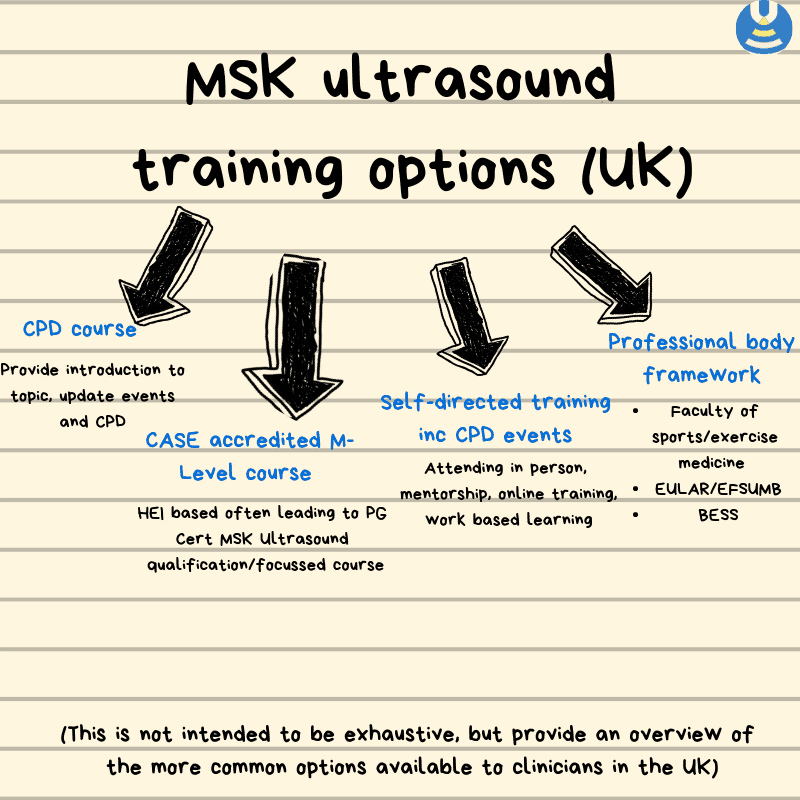A question that we receive via email and phone calls at The Ultrasound Site on a regular basis is ‘ how do I start training in musculoskeletal ultrasound?’ and more specifically reading between the lines – What should I do to ensure that I am supported by my professional body and covered by my relevant professional insurance? . This is not an easy one to answer for all. We initially produced a blog post on ‘How to train in MSK Ultrasound’ in 2017, however feel a further update is required with some key points of advice. Read the earlier version for an overview of ‘Sonography’.
I think it is useful to start by setting of the scene. Ultrasound has seen a dramatic increase in use over the past 15-20 years fuelled by a dramatic improvement in technology that has led to reduce costs and increased accessibility of systems. For example there are now several handheld ultrasound systems on the market -some wireless! Ultimately, the increased frequency of utilising diagnostic ultrasound within musculoskeletal care has accelerated away from what is offered from an educational perspective. As a result of this growth of use there are a number of different clinical domains where ultrasound is utilised and these can be seen in Figure 1 below. This can be simplified into the point of care ultrasound use (POCUS), research and traditional radiology use. This is quite a simplified version but I think captures the main areas. The less clear area for training is the ‘POCUS’ group.
As you can see from the diagram particularly in the point of care there are many different professions that now utilise ultrasound imaging to inform their practice. Alongside this there is no overarching standard of education that captures all of these different professionals. Due to this lack of clarity, we have seen UK professional bodies developing their own training programs and guidance documents to meet the needs of their members and give them clarity.
It is also important to be aware of groups such as the Consortium of Accredited Sonographic Education (CASE) who provide accreditation to PG Cert MSK ultrasound programs based in higher education institutions as well as the majority of other medical ultrasound programs. As the Chartered Society of Physiotherapy and College of Podiatry are now member organisations of CASE there is an increasing likelihood that members of these professions will look to complete PG Cert MSK ultrasound programs with CASE accreditation. Figure 2 demonstrates some of the training options available currently within the UK and is intended to provide an overview rather than exhaustive list of options.
To try and provide some sensible advice for all professionals from different medical and allied health backgrounds please read the 4 advice points below.
- Understand the position of your professional body in their expectation regarding your training. Pay particular attention to whether diagnostic MSK ultrasound is included within your scope of practice and as a result clarify if you are covered by your professional liability insurance. Establish what level of training you are required to complete- eg weekend course, HEI program etc. Are there any recommendations?
- Consider what clinical environment you are going to use ultrasound in and how/if you have access to an ultrasound machine. Read our other articles on ultrasound standards.
- Depending on the outcome of ‘1’, consider how you are going to access training that meets your requirements. Many initially attend a weekend CPD event to develop their understanding of the uses of musculoskeletal ultrasound and the practical skills required. The majority will then go on to consider further more formal training programs potentially run by Universities.. CPD weekend courses enable you to make this decision in an informed way.
- Mentorship. This has always been a significant barrier to new users learning ultrasound. As part of any formal, competency-based program there is an expectation that you will have a mentor who will assist you with the development of a logbook. Traditionally this has been 250 ultrasound scans and reports. Consider early on how you will access mentorship and peer support. You will need guidance and feedback on images and clinical decisions.
Hopefully this article has helped you to understand how you can start training in musculoskeletal ultrasound and impact your clinical practice. Please do get in touch via [email protected] if you have any questions.

